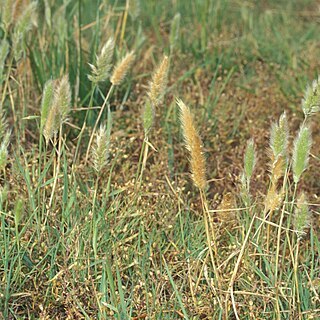Annual or perennial. Leaf blades linear, flat; ligule membranous. Panicle contracted to dense and spikelike, often bristly with numerous small deciduous spikelets. Spikelets with 1 floret, laterally compressed, without rachilla extension, falling entire, pedicel or upper part of it articulated and remaining attached to spikelet as a stipe; glumes equal, longer than floret, papery, scabrid, 1-veined, apex entire to 2-lobed, often with slender awn from apex; lemma about 1/2 as long as glumes, rounded, thin, smooth, shiny, obscurely 5-veined, veins usually shortly excurrent from truncate apex, awnless or with fine subapical awnlet or geniculate dorsal awn; palea 1/2 as long to equaling lemma. Stamens 1–3.
Annuals or perennials. Leaf-blades flat, linear. Panicle contracted or spike-like. Spikelets narrowly oblong to oblong, small, falling entire together with the pedicel or part of it; rhachilla not prolonged, eventually disarticulating below the floret. Glumes narrow, subequal, 1-nerved, membranous, rough, keeled above, entire, emarginate or 2-lobed at the tip, with a fine straight awn from the tip or between the lobes; lemma mostly broadly oblong, shorter than the glumes, truncate, thin, finely 5-nerved usually awned from near the apex, with the very fine awn often deciduous; palea as long as the lemma or shorter.
Spikelets 1-fld, articulated a little below the glumes; glumes equal, membranous, entire or 2-lobed, 1-veined, the vein excurrent as an awn from the tip or between the lobes; lemma much shorter than the glumes, very delicate in texture, often with a short, fragile, terminal awn; palea about equaling the lemma and of similar texture; tufted grasses with flat lvs, elongate, membranous ligule, and dense, ovoid to cylindric, spike-like panicles. 10, mainly temp. Eurasia.
Glumes 2, subequal to slightly unequal, 1-nerved, membranous, dorsally rounded below and usually keeled towards the apex, the flanks thinner in texture than the somewhat hardened dorsal surface, with the apex entire to shortly 2-lobed, unawned or awned from between the sinuses or slightly below the apex if entire; awn straight, slender.
Lemma awned or awnless, shorter than the glumes (excluding the awn), obscurely 5 (very rarely 3-)-nerved, thinly membranous, hyaline, with the apex truncate, the lateral nerves usually excurrent into short mucros; awn straight, slender, usually deciduous, rarely reduced to a mucro or completely absent.
Spikelets pedicelled, 1-flowered, laterally compressed, gaping at length, falling entire, awned, with an obtuse to acute basal callus; rhachilla disarticulating above the glumes, not produced beyond the floret; floret hermaphrodite, shorter than the glumes (except for the awn).
awned from the tip or from between minute lobes, the awns slender, straight; rachilla not produced beyond the florets; lemma much shorter than the glumes, hyaline, with a straight slender awn, shorter than the awns of the glumes; palea present.
Caryopsis elliptic to obovate-elliptic in outline, terete in cross-section, free between the slightly indurate lemma and palea; hilum short; embryo 1/4-1/3 the length of the caryopsis.
Palea as long as or slightly shorter than the body of the lemma, 2-nerved, 2-keeled, very thinly membranous, hyaline.
Ovary glabrous; styles distinct, very short; stigmas short, plumose, laterally exserted.
Inflorescence a many-flowered panicle, usually condensed, rarely somewhat open.
Annuals or perennials with slender culms.
Ligule a scarious membrane.
Lodicules 2, rather small.
Stamens 3.

